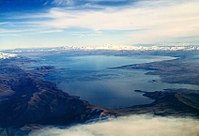
Photo from wikipedia
Abstract Subglacial topography is an important feature in numerous ice-sheet analyses and can drive the routing of water at the bed. Bed topography is primarily measured with ice-penetrating radar. Significant… Click to show full abstract
Abstract Subglacial topography is an important feature in numerous ice-sheet analyses and can drive the routing of water at the bed. Bed topography is primarily measured with ice-penetrating radar. Significant gaps, however, remain in data coverage that require interpolation. Topographic interpolations are typically made with kriging, as well as with mass conservation, where ice flow dynamics are used to constrain bed geometry. However, these techniques generate bed topography that is unrealistically smooth at small scales, which biases subglacial water flowpath models and makes it difficult to rigorously quantify uncertainty in subglacial drainage patterns. To address this challenge, we adapt a geostatistical simulation method with probabilistic modeling to stochastically simulate bed topography such that the interpolated topography retains the spatial statistics of the ice-penetrating radar data. We use this method to simulate subglacial topography using mass conservation topography as a secondary constraint. We apply a water routing model to each of these realizations. Our results show that many of the flowpaths significantly change with each topographic realization, demonstrating that geostatistical simulation can be useful for assessing confidence in subglacial flowpaths.
Journal Title: Journal of Glaciology
Year Published: 2020
Link to full text (if available)
Share on Social Media: Sign Up to like & get
recommendations!